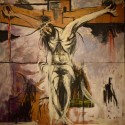Coming Out of the Institutional Religious System – The “IRS”
A guest blog by John and Katherine Matthews.
Unfortunately we missed National Coming Out day on Sunday, October 11. Better late than never though, so in honor of that special day, it’s time to officially confirm that we are out of the IRS, aka the Institutional Religious System. Yes, it’s true.
Thinking back to my earliest adult days, I’ve always felt different than everyone else in the IRS. Those closest to me could always tell, especially those in “leadership”. Many would say they just “had a sense” that I was different. I did my best to conform and fit in but to no avail. It was like I was detected as a foreign object, outed and then expelled. Interestingly, I was attracted to others who were like me and ultimately married one. Together, we have experienced rejection, stonewalling and murder of our souls and often had to extract ourselves from branch offices of the IRS to preserve our sanity. We’ve been out for a very long time but it is time to officially confirm it. This post is written to those like us to encourage you that you are not alone and in fact more sane than you may think.
We are often asked, is there any purpose for the Institutional Religious System? Does God not work in the IRS? While our perspective is the Christian version of the IRS (or Christendom), we humbly suggest these are the wrong questions. A better one would be “What is happening in the world today with the IRS and how should I respond?” After decades of trying to fit in and even “reform” the system, we have firmly decided to come out of the IRS and will attempt to express why. However, first a definition of what we mean by the term:
An Institutional Religious System is an organized human entity that includes common beliefs, doctrinal positions and moral codes, hierarchical positions (usually career, paid salary ones), denominational organizations and typically meets in a building (usually owned by the group) known as a “local church”. All organizations or “ministries” that align, promote or feed that system are also part of it. An imperfect definition for sure but hopefully clarifies the term somewhat. Now, for our three top reasons why we came out:
- Jesus never came to establish an institution and in fact was clear about his intent to destroy the one that existed in his day.
It is hard to express the pervasiveness of temple based religion in first century Judaism. The physical temple in Jerusalem was everything. All of the religious life of a Jew orbited around the physical structure and the associated human structure that operated it. The high priest was at the top of the hierarchy. The Sanhedrin was the assembly or council of leaders. Scribes created the supporting religious documents. Teachers of the Law taught them. Pharisees and Sadduccees were some of the sects within the overall religious system. All of this centered around the physical temple, with all of its rituals and requirements, where God was believed to reside deep inside within the Holy of Holies. Jesus, their Messiah, came to destroy it. Meditate on just a few samples of his own words and those who opposed him:
- “Believe me, a time is coming when you will worship the Father neither on this mountain nor in Jerusalem.” John 4:21
- “Destroy this temple, and I will raise it again in three days.” John 2:19
- “As for what you see here, the time will come when not one stone will be left on another; every one of them will be thrown down.” Luke 21:6
- “We heard him say, ‘I will destroy this temple made with human hands and in three days will build another, not made with hands.’ ” Mark 14:58
Putting these and other accounts together with his disciples’ explanation that he was speaking of the temple of his body when talking about rebuilding it, we can summarize Jesus overall message this way:
“Temple based religion is now over. My resurrected body will be the eternal temple. Worship can occur anywhere and is not limited to a physical place or structure. BTW, just to make sure you fully understand this, the physical temple you see in front of you will be destroyed within a generation.”
Think through the implications of this! No wonder he was crucified. This is a revolutionary destruction of the IRS of Jesus day. Why then have humans insisted on trying to rebuild it ever since?
- Reformation and/or revolutionary change typically come from outside not inside a system or organization
Many examples could be cited here but I’ll reference two from religious history and one from business.
Paul – Not long after the establishment of the church in Jerusalem, Peter experienced the vision of the sheet being let down from heaven filled with all kinds of unclean things and was encouraged by God to partake of a meal which no observant Jew would ever consider. Even though this was correctly seen by Peter and his fellow apostles as a metaphor for inclusion of the Gentiles in the community of Jesus followers, they did nothing about it. It took a radical outsider named Paul to take up the challenge to preach the gospel to the “unclean” Gentiles and also challenge the Jerusalem church leadership on the issue of salvation by faith alone. This may have been one of the first serious challenges to what was the embryonic beginning of the IRS in Jerusalem. (Some believe that the “Judaizers” referred to by Paul in his letters were emissaries from the IRS in Jerusalem.) The outcome of his outsider challenge by should be obvious to all.
Martin Luther – Beginning initially as a Catholic priest, as Martin Luther increasingly pursued the concepts of salvation by faith and the priesthood of all believers, he eventually was excommunicated from the Catholic Church as a heretic. From this position outside the IRS of his day, he developed his 97 theses, contributed to the concept of having the bible translated to the language of the common people and lit the fire that became the Protestant Reformation. While there is much more to the story than this quick summary, there can be no doubt that this revolution of the Christian faith came from outside rather than inside the organized church of his day.
Personal Computer – Perhaps an odd example from business but another case of revolution coming from outside the mainstream. In the mid-20th century, right up to the 1970’s, the dominant computing platform was the mainframe computer most often supplied by the market leader, IBM. It took an upstart company named Apple (to be fair Commodore and Tandy were also in the mix) to create the first “personal computer” to challenge the dominance of the mainframe. While IBM had experimented with the concept, this radical innovation came from outside the computing “institution” and was so successful that IBM soon got on board and developed the first IBM PC in the early 1980’s. Together with Microsoft, the computer was changed forever. In the 1970’s, computers were housed in large rooms or computing centers. Now we keep them in our pockets.
- The convergence of technology, the internet and renewed interest in spiritual things is already democratizing faith.
Put another way, hierarchical, institutional religion is already under a sentence of death. Pick your favorite metaphor. The 40 year death march in the desert has begun. The horse has already left the barn. The genie is out of the bottle.
We have written about this in previous posts such as “21st Century Reformation” and “Do you know what time it is? (Part 2)” . Our friend Stephen Crosby has recently blogged about the growing phenomenon of the “Nones and Dones” who are leaving institutional Christianity in huge numbers. Take the time to read these posts and familiarize yourself with the times we are living in. This is unlike anything we have seen in the past and it will not be stopped.
Perhaps the saddest aspect of this modern phenomenon is that what most of the world knows as “Christianity” is not only not leading the charge but in fact is resisting it through the IRS. This should not be the case. If you have any doubt about this, check out this recent Washington Post story about Oprah Winfrey’s “Belief” project . It should be obvious that what is happening is much larger than anything the IRS can control. The “local church” cannot tweak, adjust or even reform their programs to adapt.
The “Nones and Dones” are already part of this revolution. As it accelerates, mature Jesus followers will be priceless resources to give shape to whatever is emerging. However, they cannot do this while reeking of institution. That is why we have come out of the IRS. The Body of Christ is emerging in a new way and is in the midst of crossing the Jordan. We do not intend to die in the desert as the Promised Land awaits.
Reposted by permission.
Copyright 2015, Dr. Stephen R. Crosby, www.stevecrosby.org Permission is granted to copy, forward, or distribute this article for non-commercial use only, as long as this copyright byline, in totality, is maintained in all duplications, copies, and link references. For reprint permission for any commercial use, in any form of media, please contact stephrcrosby@gmail.com.
Would you like to partner with us in distributing our materials and perhaps generate some income for yourself? Please go to www.stevecrosby.com for details of our Affiliate program. This ministry is sustained by the freewill offerings of those believe in the message of a radical grace in a new covenant understanding. If this article has been a blessing to you, would you prayerfully consider making a tax-deductible contribution through our Paypal button to help? Thank you and God bless you.The post Coming Out of the Institutional Religious System – The “IRS” appeared first on Stephanos Ministries .




